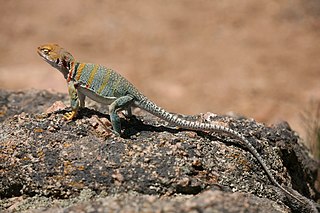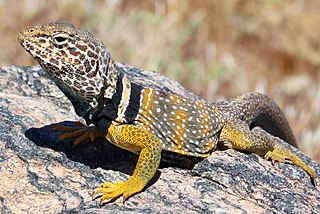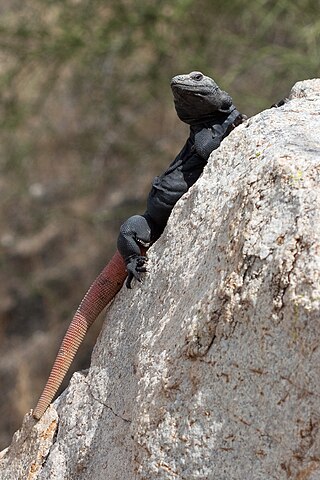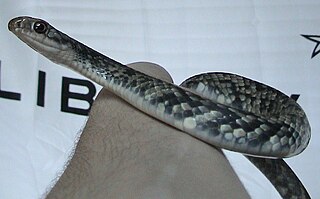
The Crotaphytidae, or collared lizards, are a family of desert-dwelling reptiles native to the Southwestern United States and northern Mexico. Alternatively they are recognized as a subfamily, Crotaphytinae, within the clade Pleurodonta. They are very fast-moving animals, with long limbs and tails; some species are capable of achieving bipedal running at top speed. This species is carnivorous, feeding mainly on insects and smaller lizards. The two genera contain 12 species.

Gambelia is a genus of lizards, commonly known as leopard lizards, within the family Crotaphytidae. Leopard lizards are indigenous to arid environments of southwestern North America.

Crotaphytus is a genus of lizards, commonly known as collared lizards, in the family Crotaphytidae. Member species are small to medium-sized predators indigenous to the American southwest, Baja peninsula, and Mexico. Including the tail, they can be as small as 7 in (18 cm) or as long as 14 in (36 cm), and are characterized by distinct bands of black or brown around the neck, to which their common names refer.

The zebra-tailed lizard is a species of lizard in the family Phrynosomatidae. The species is native to the Southwestern United States and adjacent northwestern Mexico. There are nine recognized subspecies.

The common collared lizard, also commonly called eastern collared lizard, Oklahoma collared lizard, yellow-headed collared lizard, and collared lizard, is a North American species of lizard in the family Crotaphytidae. The common name "collared lizard" comes from the lizard's distinct coloration, which includes bands of black around the neck and shoulders that look like a collar. Males can be very colorful, with blue green bodies, yellow stripes on the tail and back, and yellow orange throats. There are five recognized subspecies.

Gambelia sila, commonly known as the blunt-nosed leopard lizard, is a species of lizard in the family Crotaphytidae. The species is endemic to southern California.

The Great Basin collared lizard, also known commonly as the desert collared lizard or the Mojave black-collared lizard, is a species of lizard in the family Crotaphytidae. The species is endemic to the Western United States.

The Baja California leopard lizard, also known commonly as Cope's leopard lizard, is a species of lizard in the family Crotaphytidae. The species is endemic to Baja California and adjacent southern California.

The Baja California collared lizard or Baja black-collared lizard is a species of lizard in the family Crotaphytidae. The species is endemic to southern California and Baja California (Mexico).

Sauromalus ater, also known as the common chuckwalla or northern chuckwalla, is a species of lizard in the family Iguanidae. It inhabits the Sonoran and Mojave Deserts of the Southwestern United States and northwestern Mexico. Its range extends from eastern California, Utah, and Nevada south to Baja California and Sonora.

The long-nosed snake is a species of nonvenomous snake in the family Colubridae. The species is endemic to North America. It has two recognized subspecies. The other species in the genus were previously considered subspecies.

Crotaphytus reticulatus, commonly called the reticulate collared lizard, is a species of moderately sized lizard in the family Crotaphytidae. The species is native to semiarid, rocky regions of the Tamaulipan mezquital. Its range includes the US state of Texas and the Mexican states of Coahuila, Nuevo León, and Tamaulipas. Of all the species in the family Crotaphytidae, C. reticulatus is the only species which is not restricted to rocky habitats.

The eastern racer, or North American racer, is a species of nonvenomous snake in the family Colubridae. The species is endemic to North America and Central America. Eleven subspecies, including the nominotypical subspecies, are recognized, which as a group are commonly referred to as the eastern racers. The species is monotypic in the genus Coluber.

Hypsiglena torquata, the night snake, is a species of rear-fanged colubrid. It is found in Mexico. It is characterized by dark brown systematic blotches down its back and sides, a bar behind each eye, vertical pupils, and neck adornment. It is active in the twilight and at night. It is not dangerous to humans.

The long-nosed leopard lizard is a species of relatively large North American lizard in the family Crotaphytidae. Gambelia wislizenii ranges in snout-to-vent length (SVL) from 8.3 to 14.6 cm. It has a large head, a long nose, and a long round tail that can be longer than its body. It is closely related to the blunt-nosed leopard lizard, which closely resembles the long-nosed leopard lizard in body proportions, but has a conspicuously blunt snout. The species G. wislizenii, once considered part of the genus Crotaphytus, is under moderate pressure because of habitat destruction but is categorized as "least concern".

The venerable collared lizard is a species of lizard in the family Crotaphytidae. The species is native to northern Mexico.
Grismer's collared lizard, also known commonly as the Sierra los Cucapas collared lizard and el cachorón de Sierra de los Cucapas in Mexican Spanish, is a species of lizard in the family Iguanidae. The species is endemic to Baja California, Mexico.
Crotaphytus dickersonae, also known commonly as Dickerson's collared lizard, the Mexican collared lizard, the Sonoran collared lizard, and el cachurón de azul de collar in Spanish, is a species of lizard in the family Crotaphytidae. The species is endemic to Mexico.
















